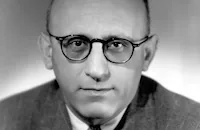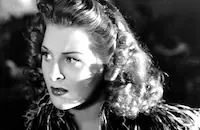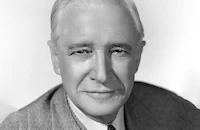Son of Dracula

Brief Synopsis
Cast & Crew
Robert Siodmak
Robert Paige
Louise Allbritton
Evelyn Ankers
Frank Craven
J. Edward Bromberg
Film Details
Technical Specs

Synopsis
At a small Southern train station, Dr. Harry Brewster and Frank Stanley await the arrival of Count Alucard, a friend of Katherine Caldwell, Frank's fiancée, and are surprised when only his luggage appears. Meanwhile, anxious for Alucard's arrival, Katherine wanders through the swamp to the run-down home of Queen Zimba, a voodoo practitioner, who warns her that death comes with the count. Before Zimba can tell Katherine more, however, a bat appears and frightens her to death. That evening, a reception is held for Alucard at the family plantation, Dark Oaks, but the invalid Colonel Caldwell is forced to retire before the guest of honor arrives. Alucard then transforms himself into a bat, enters the Caldwell home and kills the old colonel. Meanwhile, Frank tries to convince Katherine to give up the occult, with little success. Later, the colonel is examined by Brewster and Frank, who only find two small marks on his neck. When Brewster realizes that Alucard is Dracula spelled backwards, he calls Professor Lazlo, a Hungarian authority on vampires, who warns Brewster to beware of the count. During the formal reading of the colonel's will, Katherine produces a newer will, one which leaves Claire, the younger daughter, all cash and securities, while endowing Dark Oaks to Katherine. Suspicious of Katherine's relationship to Alucard, Brewster and Claire go to the guest house and search the count's belongings, only to find his bags empty. Brewster then insists that Claire leave Dark Oaks and swear out an insanity complaint against Katherine. Later, Katherine goes into the moors, where she watches Alucard materialize from the swamp waters. The two soon marry, after which Frank confronts the count and orders him to leave town. When he refuses, Frank shoots Alucard, but the bullets travel through him, killing Katherine. Frank runs from Dark Oaks, collapsing in a graveyard, where both a crucifix and the sunrise save him from the count. Frank then goes to Brewster's home and tells him of Katherine's strange death, but the physician later finds her "alive" in the company of her new husband. The newlyweds tell Brewster that Alucard is doing "scientific research" and they no longer wish to socialize with her old friends. The next morning, Brewster learns there is no legal foundation in his insanity complaint against Katherine. When Frank then turns himself in for Katherine's "murder," Brewster argues that Frank is insane, but Sheriff Dawes insists on taking the confessed killer back to Dark Oaks. There, the sheriff finds a dead Katherine in her coffin. That night, Brewster meets with Lazlo, who confirms his belief that they are dealing with a vampire. While Lazlo explains the supernatural powers of the vampire, Alucard appears before them and threatens to kill them, only to be turned away when Lazlo produces a crucifix. Their fears that Katherine too has become a vampire prove well-founded when she visits Frank in his jail cell and attempts to convince him to become an immortal. He refuses, but she tells him that he has no choice, as she has already bitten his neck. She then asks him to kill Dracula by either burning his grave or driving a stake through his heart. With Katherine's help, Frank escapes from jail and sets the count's coffin afire, then watches the vampire die as the sun rises. He then returns to Dark Oaks, where, in the presence of all, he sets Katherine's coffin afire as well, releasing her from the vampire's curse.

Director

Robert Siodmak
Cast

Robert Paige

Louise Allbritton

Evelyn Ankers

Frank Craven

J. Edward Bromberg

Samuel S. Hinds
Adeline Dewalt Reynolds
Patrick Moriarity
Etta Mcdaniel

George Irving

Lon Chaney [jr.]
Jack Rockwell
Robert Dudley
Jess Lee Brooks
Sam Mcdaniel

Walter Sande
Joan Blair
Charles Moore
Emmett Smith
Cyril Delevanti
Charles Bates
Crew
Ford Beebe
Ford Beebe
Bernard B. Brown
Donald H. Brown
Charles Carroll
R. A. Gausman
Saul Goodkind
John B. Goodman
Jack Gross
Martin Obzina
E. R. Robinson
George Robinson
H. J. Salter
Melville Shyer
Curtis Siodmak
Eric Taylor
Vera West

Film Details
Technical Specs

Articles
Son of Dracula
One of Universal's most unique offerings from its classic horror oeuvre, Son of Dracula is also one of the most hotly debated among fans of the genre, generally over the casting of Lon Chaney, Jr. in the role of Count Dracula. Some argue that Chaney, Jr.'s physicality is lumbering, uncomfortable and ill-suited to fill the shoes of original Dracula star Bela Lugosi whose thick Hungarian accent and old world elegance helped make his name forever synonymous with the role. To others, however, Chaney, Jr. puts his own stamp on the role, giving an understated, menacing and effective performance.
Bela Lugosi was not the only famous shadow looming over Lon Chaney, Jr. in Hollywood. Born Creighton Chaney in 1906, he was the son of silent movie star Lon Chaney, known as the "Man of a Thousand Faces" due to his astonishing ability to completely transform himself through makeup in films such as The Hunchback of Notre Dame (1923) and The Phantom of the Opera (1925). Following a difficult childhood and a relatively non-showbiz life though adulthood, Chaney, Jr. began his film career only after his father's death in 1930. Originally credited onscreen with his birth name, Creighton Chaney, he gained acting experience through a wide variety of film roles, including Lennie in the critically acclaimed Of Mice and Men (1939). He changed his onscreen name to Lon Chaney, Jr. in 1935, and after landing the title role in Universal's hit 1941 horror film The Wolf Man, he became increasingly associated with playing monsters and was expected by Universal to follow in his father's footsteps.
Son of Dracula's director, Robert Siodmak, was one of many established film professionals who fled Germany during the rise of the Third Reich. Following a productive stint in France, cut short again by Hitler's invasion, Siodmak eventually settled in Hollywood where he paid his dues making B-movies before going on to direct a number of stylish thrillers and films noir including Phantom Lady (1944), The Killers (1946), The Spiral Staircase (1946) and Criss Cross (1949).
Siodmak's brother Curt established himself as a writer in Hollywood with credits including the screenplays for The Wolf Man and I Walked With a Zombie (1943) as well as the popular 1942 science fiction novel Donovan's Brain. Curt had written the original story for Son of Dracula and arranged through his connections for brother Robert to direct the film. However, as soon as Robert climbed into the director's chair, he fired Curt from his job as screenwriter on the picture and replaced him with another writer, Eric Taylor. "I understand that," said Curt in a 1988 interview, "because, between brothers, who is going to have the authority?" In the end, Eric Taylor received onscreen credit for the Son of Dracula screenplay, while Curt received story credit.
The special effects wizard on Son of Dracula was John P. Fulton, who began his career as an assistant (uncredited) on the landmark film Frankenstein (1931) and eventually rose to become the head of Universal's Special Effects department. His innovative work on early films like The Invisible Man (1933) and Bride of Frankenstein (1935) helped lay the groundwork for the astonishing modern effects he created for Son of Dracula. Fulton went on to win three Academy Awards for his special effects work on later films, including The Ten Commandments (1956) in which he created the celebrated parting of the Red Sea sequence, which left audiences gasping in amazement.
One of Universal's most frequently used leading ladies, Evelyn Ankers, who co-starred with Lon Chaney, Jr. in several thrillers, has a small supporting role in Son of Dracula as Katherine's sister Claire. The lesser known Universal contract player Louise Allbritton makes a memorable impression in the female lead as the morbidly obsessed Katherine who becomes Dracula's willing bride.
Son of Dracula remains an underrated eerie gem of the classic horror genre with the dark undercurrent of a noir. Regardless of where you stand on the debate about Chaney, Jr. as Dracula, his performance is fascinating to watch. Chaney, Jr., who has the distinction of being the only actor to have portrayed all four of Universal's major horror characters on film (Count Dracula, The Wolf Man, Frankenstein's Monster and The Mummy), avoids the trappings of trying to imitate Bela Lugosi's iconic performance and makes the role his own. Over the years fans and critics of the genre have rediscovered the film and have come to appreciate Son of Dracula as a unique and satisfying contribution to Universal's horror canon.
By Andrea Passafiume

Son of Dracula
Quotes
Trivia
Notes
The working title of this film was Destiny. According to Hollywood Reporter news items, actor Alan Curtis was replaced by Robert Paige in the role of "Frank Stanley" after Curtis suffered a knee injury during the making of another Universal film, Flesh and Fantasy (see entry above). According to modern sources, George Waggner was originally set to produce the film, but became unavailable due to extended production on Phantom of the Opera (see entry above). In a modern interview, story writer Curtis Siodmak claims that he was originally hired to write the screenplay for Son of Dracula, but was fired because of "sibling rivalry" with his brother Robert after Robert assumed directorial duties on the film. Modern sources add George Meeker (Party guest), Ben Erway and Robert Hill to the cast and credit Jack Pierce as makeup artist and John P. Fulton with special effects. This was the third "Dracula" film produced by Universal, following the 1936 feature Dracula's Daughter (see AFI Catalog of Feature Films, 1931-40; F3.1122). The next Universal film to feature the "Dracula" character was the 1944 picture, House of Frankenstein (see entry above). For more information on films featuring the character of "Dracula," please consult the Series Index and see the entry for Dracula in AFI Catalog of Feature Films, 1931-40; F3.1121.















